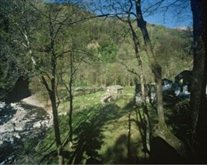The Piero rock
One of the few such examples in the Luino district, this rock preserves scratched and carved inscriptions dating back to 2000 B.C.
This large rock, in the like-named subalpine village built on a cliff overlooking the river Giona, is notable for its scratched and carved decorations dating back to 2000 B.C. The value of these petroglyphs is considerable, because they represent figures and symbols typical of the pagan age.
The rock is therefore of great cultural importance as regards the area's historical origins. In addition, it preserves traces of the interest that it evoked over the course of the centuries, when it was used in religious rituals linked initially to the adoration of nature, and later to Christianity. In fact, one can see the way in which the pagan symbols were replaced, during the Middle Ages, by numerous decorative crosses, of evident Carolingian iconographic influence.
Some of the inscriptions on the Piero rock, when compared with others in neighbouring locations, show that these areas were already inhabited very early on in history, and more precisely from the second millennium B.C.
This large rock, in the like-named subalpine village built on a cliff overlooking the river Giona, is notable for its scratched and carved decorations dating back to 2000 B.C. The value of these petroglyphs is considerable, because they represent figures and symbols typical of the pagan age.
The rock is therefore of great cultural importance as regards the area's historical origins. In addition, it preserves traces of the interest that it evoked over the course of the centuries, when it was used in religious rituals linked initially to the adoration of nature, and later to Christianity. In fact, one can see the way in which the pagan symbols were replaced, during the Middle Ages, by numerous decorative crosses, of evident Carolingian iconographic influence.
Some of the inscriptions on the Piero rock, when compared with others in neighbouring locations, show that these areas were already inhabited very early on in history, and more precisely from the second millennium B.C.





